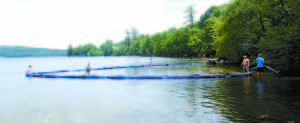Experimental barrier to clean stormwater draped across Long Lake
 After heavy rains, we have all seen brown water run into our pristine lakes. But what if that murky stormwater could be cleaned before it got into the lake?
After heavy rains, we have all seen brown water run into our pristine lakes. But what if that murky stormwater could be cleaned before it got into the lake?
That question is exactly what Lakes Environmental Association, Mackworth-Enviro and the University of Southern Maine are trying to answer.
Last Thursday, the three groups worked together to install two temporary experimental barriers in Crystal Lake and Long Lake that are designed to filter out phosphorus and sediments before they enter the lake. The barriers, which drape like curtains hanging from the surface to the bottom are installed around a culvert drainage inlet at the Long Lake boat launch in Harrison and ditch drainage inlet by the Crystal Lake boat launch. Both the culvert and ditch carry stormwater from a mix of developed land in the lakes’ watersheds. The blue curtains are made up of an impermeable barrier that isolates the incoming stormwater from the surrounding lake water. However, in each curtain there are six square “windows†where the water can pass through and receive treatment before entering the lake. Phosphorus, the nutrient that controls algae growth, is the primary target for removal by the curtains but sediment and other pollutants will also receive treatment.
The curtains were designed and deployed by Mackworth-Enviro, which is a Maine company that specializes in aquatic curtains and barriers that screen or filter water around sensitive areas. A sampling plan to test the efficiency of the filter technology variations was designed by Dr. Karen Wilson at the University of Southern Maine and will be implemented by USM students and the Lakes Environmental Association.
To evaluate how well the different treatment methods are working, the filter barriers will remain in the lakes for several storm events. Water testing will be done at the culvert or ditch inlet as well as on the inside and outside of the individual treatment windows. The curtains will likely come out in August or September and any debris that has collected on the inside of the barriers will be removed.
This project was made possible by a fund-matching grant from the Maine Technology Institute, which offers early-stage investment in research, development and application of new technologies.
Depending on the outcome of the study, this innovative treatment method may be used to help mitigate pollutants from overland storm-water flow bringing nutrient-rich water into lakes or ponds through ditches or culverts, and possibly also from large construction projects along waterbodies.

